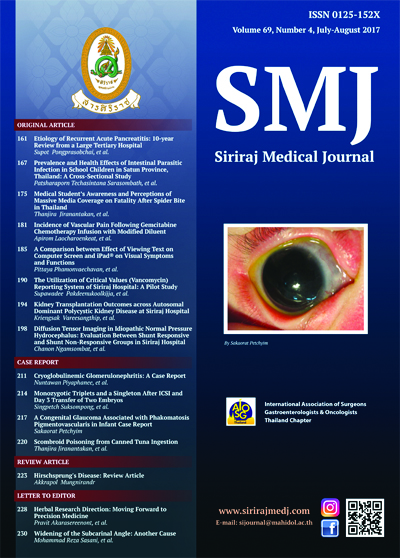Etiology of Recurrent Acute Pancreatitis: 10-year Review from a Large Tertiary Hospital
Keywords:
Etiology, recurrent acute pancreatitis, ThailandAbstract
Objective: To determine the etiology of recurrent acute pancreatitis (RAP) in a single tertiary hospital in Thailand.
Methods: Medical records, imaging and endoscopic data of patients who presented with acute pancreatitis for more than once during 2005-2014 were retrospectively reviewed and analyzed.
Results: There were 66 RAP patients over the 10-year period. Majority (69.7%) were men. Mean age was 47 ± 19 years. Thirty percent smoked and 48% drank significant alcohol (defined as ethanol >80 g/day for >5 years). Liver function test, serum triglyceride and calcium were done in every case. Ultrasonography, computed tomography and
endoscopic ultrasonography were performed in 54.5%, 53.0% and 33.3%, respectively. Genetic studies (PRSS1 and SPINK1 mutations) were performed in 9 patients (13.6%) and mutations were found for PRSS1 in 1 and SPINK1 in 2 patients. Alcohol was the most common etiology of RAP (40.9%), followed by biliary stone (27.3%), all of which
were macrolithiasis. ICP was the third most common cause (9.1%) and hereditary pancreatitis was diagnosed in 1 patient (1.5%). Seventeen patients (25.7%) had miscellaneous etiologies and 2 (3.0%) finally had idiopathic recurrent acute pancreatitis (IRAP). More than half (61%) of patients with RAP from macrolithiasis were associated with
delayed cholecystectomy after sentinel gallstone pancreatitis.
Conclusion: The most common etiologies of RAP in order were alcohol, macrolithiasis and ICP. Among RAP patients from macrolithiasis, the main cause was delayed cholecystectomy after sentinel gallstone pancreatitis.
Downloads
Published
How to Cite
Issue
Section
License
Authors who publish with this journal agree to the following conditions:
Copyright Transfer
In submitting a manuscript, the authors acknowledge that the work will become the copyrighted property of Siriraj Medical Journal upon publication.
License
Articles are licensed under a Creative Commons Attribution-NonCommercial-NoDerivatives 4.0 International License (CC BY-NC-ND 4.0). This license allows for the sharing of the work for non-commercial purposes with proper attribution to the authors and the journal. However, it does not permit modifications or the creation of derivative works.
Sharing and Access
Authors are encouraged to share their article on their personal or institutional websites and through other non-commercial platforms. Doing so can increase readership and citations.











